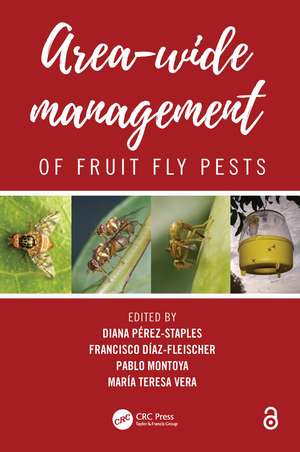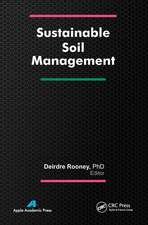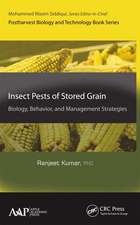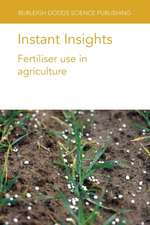Area-Wide Management of Fruit Fly Pests
Editat de Diana Perez-Staples, Francisco Diaz-Fleischer, Pablo Montoya, Maria Veraen Limba Engleză Hardback – 2 dec 2019
The first three sections of the book explore aspects of the biology, ecology, physiology, behavior, taxonomy, and morphology of fruit flies. The next two sections provide evidence on the efficacy of attractants, risk assessment, quarantine, and post-harvest control methods. The fifth and sixth sections examine biological control methods such as the Sterile Insect Technique and the use of natural enemies of fruit flies. The seventh section focuses on area-wide integrated pest management and action programs. Finally, the eighth section examines social, economic, and policy issues of action programs aimed at involving the wider community in the control of these pests and facilitate the development of control programs.
Features:
- Presents information on the biology of tephritid flies.
- Provides knowledge on the use of natural enemies of fruit flies for their biological control.
- Includes research results on models and diets used for the Sterile Insect Technique.
- Reports developments on the chemical ecology of fruit flies that contribute to make control methods more specific and efficient.
- Reviews subjects such as Holistic Pest Management and Area-Wide Management Programs including social, economic, and policy issues in various countries.
| Toate formatele și edițiile | Preț | Express |
|---|---|---|
| Paperback (1) | 449.63 lei 6-8 săpt. | |
| CRC Press – 30 iun 2021 | 449.63 lei 6-8 săpt. | |
| Hardback (1) | 829.21 lei 6-8 săpt. | |
| CRC Press – 2 dec 2019 | 829.21 lei 6-8 săpt. |
Preț: 829.21 lei
Preț vechi: 1108.22 lei
-25% Nou
Puncte Express: 1244
Preț estimativ în valută:
158.74€ • 165.63$ • 133.07£
158.74€ • 165.63$ • 133.07£
Carte tipărită la comandă
Livrare economică 13-27 martie
Preluare comenzi: 021 569.72.76
Specificații
ISBN-13: 9781138477452
ISBN-10: 1138477451
Pagini: 440
Ilustrații: 127
Dimensiuni: 178 x 254 x 25 mm
Greutate: 0.97 kg
Ediția:1
Editura: CRC Press
Colecția CRC Press
ISBN-10: 1138477451
Pagini: 440
Ilustrații: 127
Dimensiuni: 178 x 254 x 25 mm
Greutate: 0.97 kg
Ediția:1
Editura: CRC Press
Colecția CRC Press
Cuprins
Preface
Acknowledgments
Editors
Contributors
Section I Biology, Ecology, Physiology, and Behavior
Chapter 1 Identification of the Profile of Cuticular Hydrocarbons of Anastrepha curvicauda (Diptera: Tephritidae)
Ricardo Peralta-Falcón, Norma R. Robledo-Quintos, and Cesar J. Barragán-Sol
Chapter 2 Reported Long-Distance Flight of the Invasive Oriental Fruit Fly and Its Trade Implications
Carol B. Hicks, Kenneth Bloem, Godshen R. Pallipparambil, and Heather M. Hartzog
Chapter 3 Desiccation Resistance of Tephritid Flies: Recent Research Results and Future Directions
Christopher W. Weldon, Francisco Díaz- Fleischer, and Diana Pérez-Staples
Chapter 4 Mating Compatibility between Two Populations of Anastrepha fraterculus (Wiedemann) (Diptera:Tephritidae) from Argentina and Uruguay
Felicia Duarte, María V. Calvo, Soledad Delgado, María Teresa Vera, Flavio M. García, and Iris B. Scatoni
Section II Taxonomy and Morphology
Chapter 5 Review of Anastrepha (Diptera: Tephritidae) Immature Stage Taxonomy
Gary J. Steck, Erick J. Rodriguez, Allen L. Norrbom, Vivian S. Dutra, Beatriz Ronchi-Teles, and Janisete Gomes Silva
Chapter 6 A Review of the Natural Host Plants of the Anastrepha fraterculus Complex in the Americas
Vicente Hernández-Ortiz, Nancy Barradas-Juanz, and Cecilia Díaz-Castelazo
Chapter 7 Preliminary Report of Anastrepha Species Associated with "Kaniste" Fruits (Pouteria campechiana) (Sapotaceae) in the State of Campeche, Mexico
María de Jesús García Ramirez, Enrique Antonio Hernandez, Juan José Vargas Magaña, Marvel del Carmen Valencia Gutierrez, Ivonne Esmeralda Duarte Ubaldo, Enrique A. González Durán, and Lisandro Encalada Mena
Section III Chemical Ecology and Attractants
Chapter 8 Bait Stations for Controlling the First Year of Mexican Fruit Flies (Anastrepha ludens)
Hugh Conway, Guadalupe Gracia, Pedro Rendon, and Christopher Vitek
Chapter 9 Assessment of Modified Waste Brewery Yeast as an Attractant for Fruit Flies of Economic Importance in Mauritius
Nausheen A. Patel, Sunita Facknath, and Preeaduth Sookar
Section IV Risk Assessment, Quarantine, and Post-Harvest
Chapter 10 International Database on Commodity Tolerance (IDCT)
Emilia Bustos Griffin, Guy J. Hallman, Abdeljelil Bakri, and Walther Enkerlin
Chapter 11 Gamma-H2AX: A Promising Biomarker for Fruit Fly Phytosanitary Irradiation Exposure
Mohammad Sabbir Siddiqui, Phillip Taylor, and Peter Crisp
Section V Sterile Insect Technique
Chapter 12 Performance of the Tap-7 Genetic Sexing Strain Used to Control Anastrepha ludens Populations in the Citrus Region of Tamaulipas, Mexico
Salvador Flores, Sergio Campos, Enoc Goméz, Rubén Leal Mubarqui, Jorge Luis Morales-Marin, Jorge Vélez, Arturo Bello-Rivera, and Pablo Montoya
Chapter 13 Toxicological Evaluation of Corncob Fractions on the Larval Performance of Anastrepha obliqua
Marysol Aceituno-Medina, Rita Teresa Martínez-Salgado, Arseny Escobar,
Carmen Ventura, and Emilio Hernández
Chapter 14 Exploring Cost-Effective SIT: Verification via Simulation of an Approach Integrating Reproductive Interference with Regular Sterile Insect Release
Atsushi Honma and Yusuke Ikegawa
Chapter 15 Sexual Competitiveness of Anastrepha ludens (Diptera: Tephritidae) Males from the Genetic Sexing Strain Tap-7 in the Citrus Region of Montemorelos, Nuevo Leon, Mexico
Patricia López, Juan Heliodoro Luis, Refugio Hernández, and Pablo Montoya
Chapter 16 A New Diet for a New Facility: Development of a Starter-Finalizer Diet System for Rearing Colonies of the Ceratitis capitata Vienna 8 Strain at a New Facility of Mexico’s Moscamed Program
Milton Arturo Rasgado-Marroquín, Emmanuel Velázquez-Dávila, José Antonio De la Cruz-De la Cruz, Reynaldo Aguilar Laparra, Luis Cristóbal Silva Villa Real, and Marco Tulio Tejeda
Section VI Natural Enemies and Biological Control
Chapter 17 Biological Control of Anastrepha Populations in Wild Areas to Strengthen the Commercial Status of Mango Production along the Pacific Coast of Mexico
Jorge Cancino, Arturo Bello-Rivera, Jesús Cárdenas-Lozano, Fredy Gálvez-Cárdenas, Víctor García-Pérez, Eduardo Camacho-Bojórquez, Emiliano Segura-Bailon, Maximino Leyva-Castro, and Francisco Ramírez y Ramírez
Chapter 18 Use of Entomopathogenic Fungi for the Biological Control of the Greater Melon Fly Dacus frontalis in Libya
Esam Elghadi and Gordon Port
Chapter 19 Natural Parasitism and Parasitoid Releases to Control Anastrepha obliqua (Diptera: Tephritidae) Infesting Spondias spp. (Anacardaceae) in Chiapas, Mexico
Patricia López, Jorge Cancino, and Pablo Montoya
Section VII Area-Wide Integrated Pest Management and Action Programs
Chapter 20 Holistic Pest Management
Juan F. Barrera
Chapter 21 Area-Wide Management of Anastrepha grandis in Brazil
Márcio Alves Silva, Gerane Celly Dias Bezerra Silva, Joseph Jonathan Dantas de Oliveira, and Anderson Bolzan
Chapter 22 Eradication of an Outbreak of Bactrocera carambolae (Carambola Fruit Fly) in the Marajo Archipelago, State of Para, Brazil
Maria Julia S. Godoy, Wilda S. Pinto, Clara A. Brandão, Clóvis V. Vasconcelos, and José M. Pires
Chapter 23 Use of the Sterile Insect Technique in an Area-Wide Approach to Establish a Fruit Fly-Low Prevalence Area in Thailand
Suksom Chinvinijkul, Wanitch Limohpasmanee, Thanat Chanket, Alongkot Uthaitanakit, Puttipong Phopanit, Weerawan Sukamnouyporn, Chanon Maneerat, Weera Kimjong, Phatchara Kumjing, and Naowarat Boonmee
Chapter 24 Implementation of an Anastrepha spp. Risk-Mitigation Protocol for the Mango Export Industry in Cuba
Mirtha Borges-Soto, Maylin Rodríguez Rubial, Evi R. Estévez Terrero, and Beatriz Sabater-Munoz
Chapter 25 Fruit Fly Area-Wide Integrated Pest Management in Dragon Fruit in Binh Thuan Province, Viet Nam
Nguyen T.T. Hien, Vu T.T. Trang, Vu V. Thanh, Ha K. Lien, Dang Đ. Thang, Le T. Xuyen, and Rui Pereira
Chapter 26 Area-Wide Approach for the Control of Mango Fruit Flies in a Metropolis Containing Polycultures in Urban and Peri-Urban Areas in Nigeria
Vincent Umeh, Vivian Umeh, and John Thomas
Section VIII Social, Economic, and Policy Issues of Action Programs
Chapter 27 Compendium of Fruit Fly Host Plant Information: The USDA Primary Reference in Establishing Fruit Fly Regulated Host Plants
Nicanor J. Liquido, Grant T. McQuate, Karl A. Suiter, Allen L. Norrbom, Wee L. Yee, and Chiou Ling Chang
Chapter 28 Tephritid-Related Databases: TWD, IDIDAS, IDCT, DIR-SIT
Abdeljelil Bakri, Walther Enkerlin, Rui Pereira, Jorge Hendrichs, Emilia Bustos-Griffin, and Guy J. Hallman
Chapter 29 Stewed Peaches, Fruit Flies, and STEM Professionals in Schools: Inspiring the Next Generation of Fruit Fly Entomologists
Carol Quashie-Williams
Chapter 30 Phytosanitary Education: An Essential Component of Eradication Actions for the Carambola Fruit Fly, Bactrocera carambolae, in the Marajo Archipelago, Para State, Brazil
Maria Julia S. Godoy, Gabriela Costa de Sousa Cunha, Luzia Picanço, and Wilda S. Pinto
Chapter 31 Phytosanitary Education as a Component of Eradication Actions of the Carambola Fruit Fly (CFF) Bactrocera Carambolae in the Raposa Serra Do Sol Native Reserve, State of Roraima, Brazil
Maria Julia S. Godoy, Gabriela Costa de Sousa Cunha, Elindinalva Antônia Nascimento, Maria Eliana Queiroz, Luzia Picanço, Luiz Carlos Trassato, and Wilda S. Pinto
Acknowledgments
Editors
Contributors
Section I Biology, Ecology, Physiology, and Behavior
Chapter 1 Identification of the Profile of Cuticular Hydrocarbons of Anastrepha curvicauda (Diptera: Tephritidae)
Ricardo Peralta-Falcón, Norma R. Robledo-Quintos, and Cesar J. Barragán-Sol
Chapter 2 Reported Long-Distance Flight of the Invasive Oriental Fruit Fly and Its Trade Implications
Carol B. Hicks, Kenneth Bloem, Godshen R. Pallipparambil, and Heather M. Hartzog
Chapter 3 Desiccation Resistance of Tephritid Flies: Recent Research Results and Future Directions
Christopher W. Weldon, Francisco Díaz- Fleischer, and Diana Pérez-Staples
Chapter 4 Mating Compatibility between Two Populations of Anastrepha fraterculus (Wiedemann) (Diptera:Tephritidae) from Argentina and Uruguay
Felicia Duarte, María V. Calvo, Soledad Delgado, María Teresa Vera, Flavio M. García, and Iris B. Scatoni
Section II Taxonomy and Morphology
Chapter 5 Review of Anastrepha (Diptera: Tephritidae) Immature Stage Taxonomy
Gary J. Steck, Erick J. Rodriguez, Allen L. Norrbom, Vivian S. Dutra, Beatriz Ronchi-Teles, and Janisete Gomes Silva
Chapter 6 A Review of the Natural Host Plants of the Anastrepha fraterculus Complex in the Americas
Vicente Hernández-Ortiz, Nancy Barradas-Juanz, and Cecilia Díaz-Castelazo
Chapter 7 Preliminary Report of Anastrepha Species Associated with "Kaniste" Fruits (Pouteria campechiana) (Sapotaceae) in the State of Campeche, Mexico
María de Jesús García Ramirez, Enrique Antonio Hernandez, Juan José Vargas Magaña, Marvel del Carmen Valencia Gutierrez, Ivonne Esmeralda Duarte Ubaldo, Enrique A. González Durán, and Lisandro Encalada Mena
Section III Chemical Ecology and Attractants
Chapter 8 Bait Stations for Controlling the First Year of Mexican Fruit Flies (Anastrepha ludens)
Hugh Conway, Guadalupe Gracia, Pedro Rendon, and Christopher Vitek
Chapter 9 Assessment of Modified Waste Brewery Yeast as an Attractant for Fruit Flies of Economic Importance in Mauritius
Nausheen A. Patel, Sunita Facknath, and Preeaduth Sookar
Section IV Risk Assessment, Quarantine, and Post-Harvest
Chapter 10 International Database on Commodity Tolerance (IDCT)
Emilia Bustos Griffin, Guy J. Hallman, Abdeljelil Bakri, and Walther Enkerlin
Chapter 11 Gamma-H2AX: A Promising Biomarker for Fruit Fly Phytosanitary Irradiation Exposure
Mohammad Sabbir Siddiqui, Phillip Taylor, and Peter Crisp
Section V Sterile Insect Technique
Chapter 12 Performance of the Tap-7 Genetic Sexing Strain Used to Control Anastrepha ludens Populations in the Citrus Region of Tamaulipas, Mexico
Salvador Flores, Sergio Campos, Enoc Goméz, Rubén Leal Mubarqui, Jorge Luis Morales-Marin, Jorge Vélez, Arturo Bello-Rivera, and Pablo Montoya
Chapter 13 Toxicological Evaluation of Corncob Fractions on the Larval Performance of Anastrepha obliqua
Marysol Aceituno-Medina, Rita Teresa Martínez-Salgado, Arseny Escobar,
Carmen Ventura, and Emilio Hernández
Chapter 14 Exploring Cost-Effective SIT: Verification via Simulation of an Approach Integrating Reproductive Interference with Regular Sterile Insect Release
Atsushi Honma and Yusuke Ikegawa
Chapter 15 Sexual Competitiveness of Anastrepha ludens (Diptera: Tephritidae) Males from the Genetic Sexing Strain Tap-7 in the Citrus Region of Montemorelos, Nuevo Leon, Mexico
Patricia López, Juan Heliodoro Luis, Refugio Hernández, and Pablo Montoya
Chapter 16 A New Diet for a New Facility: Development of a Starter-Finalizer Diet System for Rearing Colonies of the Ceratitis capitata Vienna 8 Strain at a New Facility of Mexico’s Moscamed Program
Milton Arturo Rasgado-Marroquín, Emmanuel Velázquez-Dávila, José Antonio De la Cruz-De la Cruz, Reynaldo Aguilar Laparra, Luis Cristóbal Silva Villa Real, and Marco Tulio Tejeda
Section VI Natural Enemies and Biological Control
Chapter 17 Biological Control of Anastrepha Populations in Wild Areas to Strengthen the Commercial Status of Mango Production along the Pacific Coast of Mexico
Jorge Cancino, Arturo Bello-Rivera, Jesús Cárdenas-Lozano, Fredy Gálvez-Cárdenas, Víctor García-Pérez, Eduardo Camacho-Bojórquez, Emiliano Segura-Bailon, Maximino Leyva-Castro, and Francisco Ramírez y Ramírez
Chapter 18 Use of Entomopathogenic Fungi for the Biological Control of the Greater Melon Fly Dacus frontalis in Libya
Esam Elghadi and Gordon Port
Chapter 19 Natural Parasitism and Parasitoid Releases to Control Anastrepha obliqua (Diptera: Tephritidae) Infesting Spondias spp. (Anacardaceae) in Chiapas, Mexico
Patricia López, Jorge Cancino, and Pablo Montoya
Section VII Area-Wide Integrated Pest Management and Action Programs
Chapter 20 Holistic Pest Management
Juan F. Barrera
Chapter 21 Area-Wide Management of Anastrepha grandis in Brazil
Márcio Alves Silva, Gerane Celly Dias Bezerra Silva, Joseph Jonathan Dantas de Oliveira, and Anderson Bolzan
Chapter 22 Eradication of an Outbreak of Bactrocera carambolae (Carambola Fruit Fly) in the Marajo Archipelago, State of Para, Brazil
Maria Julia S. Godoy, Wilda S. Pinto, Clara A. Brandão, Clóvis V. Vasconcelos, and José M. Pires
Chapter 23 Use of the Sterile Insect Technique in an Area-Wide Approach to Establish a Fruit Fly-Low Prevalence Area in Thailand
Suksom Chinvinijkul, Wanitch Limohpasmanee, Thanat Chanket, Alongkot Uthaitanakit, Puttipong Phopanit, Weerawan Sukamnouyporn, Chanon Maneerat, Weera Kimjong, Phatchara Kumjing, and Naowarat Boonmee
Chapter 24 Implementation of an Anastrepha spp. Risk-Mitigation Protocol for the Mango Export Industry in Cuba
Mirtha Borges-Soto, Maylin Rodríguez Rubial, Evi R. Estévez Terrero, and Beatriz Sabater-Munoz
Chapter 25 Fruit Fly Area-Wide Integrated Pest Management in Dragon Fruit in Binh Thuan Province, Viet Nam
Nguyen T.T. Hien, Vu T.T. Trang, Vu V. Thanh, Ha K. Lien, Dang Đ. Thang, Le T. Xuyen, and Rui Pereira
Chapter 26 Area-Wide Approach for the Control of Mango Fruit Flies in a Metropolis Containing Polycultures in Urban and Peri-Urban Areas in Nigeria
Vincent Umeh, Vivian Umeh, and John Thomas
Section VIII Social, Economic, and Policy Issues of Action Programs
Chapter 27 Compendium of Fruit Fly Host Plant Information: The USDA Primary Reference in Establishing Fruit Fly Regulated Host Plants
Nicanor J. Liquido, Grant T. McQuate, Karl A. Suiter, Allen L. Norrbom, Wee L. Yee, and Chiou Ling Chang
Chapter 28 Tephritid-Related Databases: TWD, IDIDAS, IDCT, DIR-SIT
Abdeljelil Bakri, Walther Enkerlin, Rui Pereira, Jorge Hendrichs, Emilia Bustos-Griffin, and Guy J. Hallman
Chapter 29 Stewed Peaches, Fruit Flies, and STEM Professionals in Schools: Inspiring the Next Generation of Fruit Fly Entomologists
Carol Quashie-Williams
Chapter 30 Phytosanitary Education: An Essential Component of Eradication Actions for the Carambola Fruit Fly, Bactrocera carambolae, in the Marajo Archipelago, Para State, Brazil
Maria Julia S. Godoy, Gabriela Costa de Sousa Cunha, Luzia Picanço, and Wilda S. Pinto
Chapter 31 Phytosanitary Education as a Component of Eradication Actions of the Carambola Fruit Fly (CFF) Bactrocera Carambolae in the Raposa Serra Do Sol Native Reserve, State of Roraima, Brazil
Maria Julia S. Godoy, Gabriela Costa de Sousa Cunha, Elindinalva Antônia Nascimento, Maria Eliana Queiroz, Luzia Picanço, Luiz Carlos Trassato, and Wilda S. Pinto
Descriere
This book supplies the latest research on the biology, management procedures, and control strategies of fruit flies of economic importance. It considers an integrative approach covering topics including behavior, genetics, biological control, integrated pest management, host-plant interactions, trap design, and transgenics of fruit flies.
Notă biografică
Diana Pérez-Staples is a Research Professor at the Universidad Veracruzana in Xalapa, Veracruz, Mexico, where she has been a faculty member since 2008. Previously she was a postdoc at Macquarie University, Australia. Diana completed her PhD at the Institute of Ecology (INECOL, Mexico), and her masters at the National Autonomous University of Mexico (UNAM). She received her undergraduate degree from Reed College, USA. Her research is focused on the sexual behaviour of tephritid fruit flies and other insect pests, and on improving current control methods. Diana has received the L’Oréal-UNESCO fellowship for Women in Science and the Kathleen S. Anderson Award for Promising Biologists. Francisco Díaz-Fleischer has been a faculty member at the Universidad Veracruzana in Xalapa, Veracruz, Mexico since 2008. He obtained his PhD at the Institute of Ecology (INECOL, Mexico). He is interested in the relationship between behavior and life-history of tephritid fruit flies in order to improve control method.Pablo Montoya is an expert on the use of Biological Control by Augmentation and the application of the Sterile Insect Technique against fruit fly pests, with over 60 published papers in scientific journals. He is a researcher and head of the Unit of Methods Development in the Mexican Program against Fruit Flies – SENASICA-SAGARPA.Teresa Vera is an expert on fruit fly reproductive biology and the assessment of sexual competitiveness for the implementation of the Sterile Insect Technique with over 50 published papers in scientific journals. Currently she is a researcher at the Argentinean Science Institute (CONICET) and teaches at the Facultad de Agronomía y Zootecnia, Universidad Nacional de Tucumán where she is member of the Editorial Board of the Revista Agronómica del Noroeste Argentino.

















